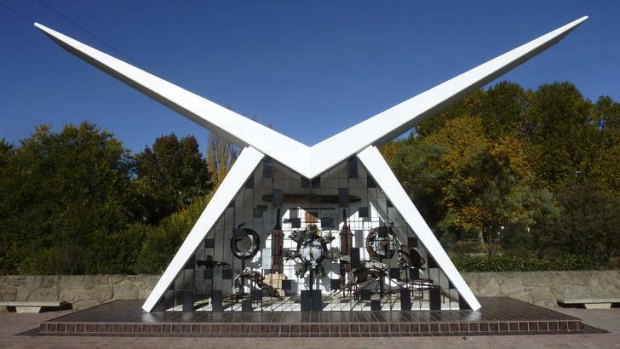
The Aviation Pioneers Memorial at Southern Cloud Park in Cooma.Credit: Tim The Yowie Man
The mass of closely spaced contour lines on the map indicates that we're not far from a place called World's End, and immersed in some of our country's most remote mountain country. It's easy to see how it got its name.
I can't see my guide, but the sound of branches cracking as he cavorts through the thick scrub indicates that he's not far ahead. It's easier for me than him for I'm following in his footsteps, or at least I'm trying to. Despite being only 20 metres or so behind him, the regrowth from fires last decade is so thick that I'm forced to bellow a cooee on more than one occasion.
We're bush-bashing our way through this wild country in search of one of Australia's most significant plane wrecks - the Southern Cloud.
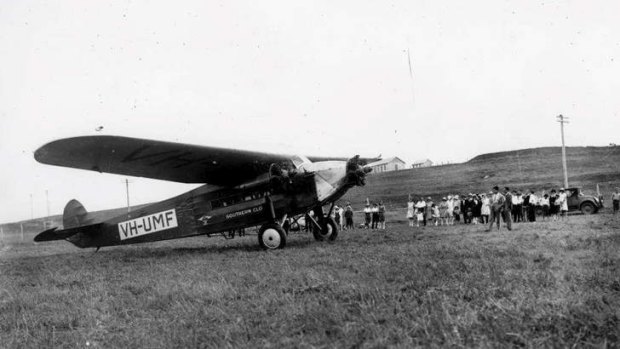
The Southern Cloud.Credit: bonzle.com
Thankfully, the majority of our morning's trek through the rugged upper valley of the Tooma River on the western side of Kosciuszko National Park hasn't been quite as strenuous. The first seven kilometres were on management tracks, hacked into the side of the mountain to allow maintenance workers to access four small dams that form a critical link in the Snowy Mountains Hydro-Electric Scheme.
It's only the last few hundred metres that have been unforgiving. After slipping on mossy rocks and exposed tree roots still sodden from a heavy overnight frost, I eventually crawl under one last fallen tree. Ahead, there's a small clearing. It's only a few metres square and my guide, Matthew Higgins, is already there. A keen bushwalker and renowned high-country historian, this is the sixth visit to the site for Higgins. Crouching beside a memorial framed by pieces of the wreck, he scrapes away some foliage to reveal its words. Along with the names of the two crew and six passengers who lost their lives, the bush memorial poignantly states: ''Lost 21st March 1931'', ''Found 26th October 1958''. Hidden in this wild country, it's easy to see why the location of the wreck remained one of Australia's biggest mysteries for almost 30 years.
Until Higgins invited me on this trek, I'd never heard of the Southern Cloud, which was one five Avro X aircraft operated by Australian National Airways, a company set up by aviation pioneers Charles Ulm and Charles Kingsford Smith. ''On the morning of 21 March, 1931, it set off on what turned out to be its last flight, from Sydney bound for Melbourne,'' Higgins explains as I try to catch my breath. ''They knew they were flying in windy and rainy weather but what they didn't know is [that] after they took off the Bureau of Meteorology revised their forecast to virtually cyclonic conditions over the alps.
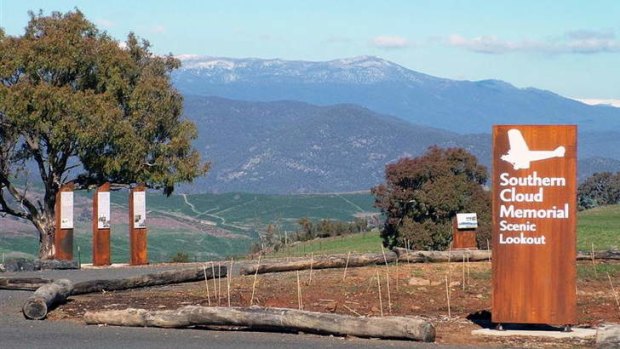
The Southern Cloud Lookout at Tumbarumba. Courtesy: www.visittumbashire.com.au
''The plane didn't make it to Melbourne and, despite an intensive search for several weeks, no sign of the plane was ever found - it was as if it disappeared into thin air.''
The search area was massive as there were reports of people claiming to have seen a plane in trouble on the afternoon of March 21 as far afield as Port Phillip Bay in Victoria.
''In world terms, it was one of the longest-running missing planes, but that all changed on 26 October, 1958, when Tom Sonter, a worker on the snowy scheme decided to take an afternoon walk. He went off-track aiming for Black Jack Mountain,'' says Higgins, pointing through the scrub in a northerly direction.
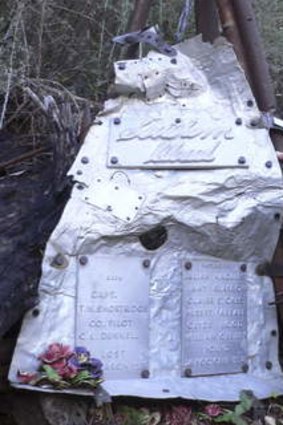
Matthew Higgins deep in thought at the site of the wreck of the Southern Cloud.Credit: Tim The Yowie Man
Sonter apparently found the going too tough and turned back, and in doing so literally stumbled on the wreck. It would have been a morbid scene with reports that human bones were lying among the wreckage.
''Within a couple of days, police and civil aviation authorities had positively identified it as the missing plane,'' Higgins says. ''The mystery had finally been solved.''
Apart from the simple bush memorial, there is very little of the wreck still at the crash site. ''In the weeks following the discovery there was a huge souveniring effort,'' Higgins says. Apparently many artefacts were taken by journalists (heaven forbid!) and aviation memorabilia collectors who rushed to the site after its discovery was splashed over the front pages of the national press. Thankfully, some of these items have recently made their way into museum collections and public displays.
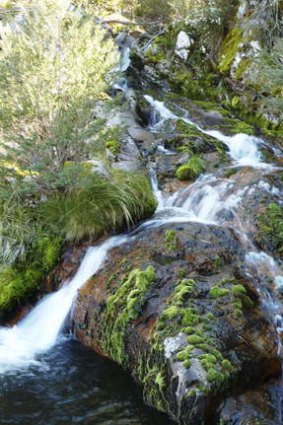
Water cascades into a small dam along the Deep Creek Aqueduct en route to the wreck.Credit: Tim The Yowie Man
As is so often the case with disasters, there are stories of passengers who cheated death by making late changes to their travel itineraries. Take Stan Baker, for example. The Sydney businessman had booked on the fateful flight but cancelled at the last minute, deciding to travel to Melbourne by train. Not surprisingly, following the Southern Cloud's disappearance, Baker reportedly developed a fear of flying that tragically proved justifiable when in he died in a plane crash near Perth in 1950. Then there's cricket great Sir Donald Bradman, who flew in the Southern Cloud from Adelaide to Goulburn ''not long before the tragedy''. In his 1950 tome, Farewell to Cricket, Bradman described the trip as a ''bumpy journey''. While it might have been a bit turbulent for ''the Don'', it must have been a terrifying last few minutes for those on the Southern Cloud's fateful flight.
''Picture it, hopelessly flying around with limited or no visibility, desperately trying to find a break in the weather, and then, bang, smashing straight into the side of the mountain,'' Higgins reflects. ''It must have been horrific.''
We linger at the site for the best part of an hour. Not that there's a lot to do here, but there's much to contemplate. We'd stay longer but, with the long hike back to the car and then four-hour-plus drive back to Canberra, and with the frost barely starting to dry out, we decide it's time to leave. Just as we are about to pay our last respects, almost on cue, three jets pass overhead, their vapour trails stretching across the sky - they're commercial passenger planes on the busy Sydney to Melbourne route. Thankfully, air travel has become far more comfortable since the pioneering days of the 1930s. Most of the passengers passing overhead are probably reclined in their comfy chairs, sipping on a wine while watching a satellite-transmitted TV show in airconditioned comfort, oblivious of the significance of the crash site directly beneath them.
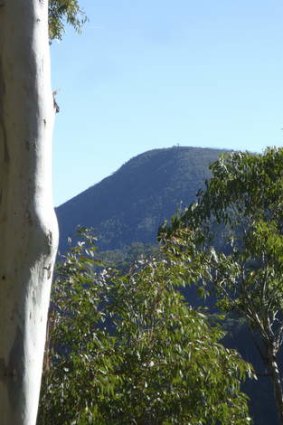
Black Jack Mountain as viewed from the Ogilvies Creek fire trail.Credit: Tim The Yowie Man
''One of the recommendations after the disappearance of the Southern Cloud was that radios be fitted in regular passenger flights so that changes in weather forecasts could be communicated to air crew,'' Higgins says.
So, although it's of little consolation to the families of those who lost loved ones when the Southern Cloud ploughed into the side of this mountain, the tragedy did leave a lasting legacy - safer air travel - and for that we should all be eternally grateful.
FACT FILE
Southern Cloud Wreck: The crash site can be accessed via the Ogilvies Creek Fire Trail off the Cabramurra-Khancoban Road. Warning: the wreck site is not signposted and, due to its remote location, the 15-kilometre return trek to the wreck should only be undertaken by experienced bushwalkers. Contact your local bushwalking club for more information. For the less adventurous, there are also a number of much more accessible lookouts, memorials and points of interest relating to the wreck.
Aviation Pioneers Memorial: Located in Cooma's Southern Cloud Memorial Park in Sharp Street (the main street), next to the Cooma Back Creek Bridge, is an impressive display featuring the propeller from the Southern Cloud, which was apparently changed by an engineer just before its fatal flight.
Cooma Visitors Centre: Hanging from the roof in this information centre at 119 Sharp Street, Cooma, is a wooden model of the Southern Cloud. A short television documentary can also be shown on request.
Cooma Cemetery: Under a row of mature pines in the main Cooma Cemetery (off Mittagang Road) is a memorial plot for the victims of the Southern Cloud.
Tumbarumba Museum: Located at 10 Bridge Street, this museum features an exhibition on the history and disappearance of the Southern Cloud.
The Southern Cloud Memorial Lookout: Located on the Tooma Road near Tooma (about 32 kilometres from Tumbarumba), this lookout offers expansive views of western Kosciuszko (although the actual wreck site cannot been seen as it's obscured by folds in the ranges).
National Museum of Australia, Canberra: The museum holds a number of artefacts from the wreck of the Southern Cloud, including a clock recently donated by a private collector. In the Eternity Gallery there is an audio-visual display highlighting Tom Sonter's discovery of the wreck in October 1958.
CONTACT TIM
Email: timtheyowieman@bigpond.com or Twitter: @TimYowie or write to me c/o The Canberra Times, 9 Pirie Street, Fyshwick.
Sign up for the Traveller newsletter
The latest travel news, tips and inspiration delivered to your inbox. Sign up now.